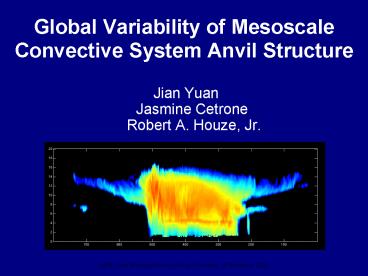Global Variability of Mesoscale Convective System Anvil Structure - PowerPoint PPT Presentation
1 / 17
Title:
Global Variability of Mesoscale Convective System Anvil Structure
Description:
MODIS/Aqua Clouds 1km and 5km 5-Min L2 Wide Swath Subset ... Subdivide Cold and Warm by size. Selection of Mesoscale Convective Systems. Cold MCS (Smallest 30 ... – PowerPoint PPT presentation
Number of Views:41
Avg rating:3.0/5.0
Title: Global Variability of Mesoscale Convective System Anvil Structure
1
Global Variability of Mesoscale Convective System
Anvil Structure
- Jian YuanJasmine Cetrone Robert A. Houze, Jr.
ARM Cloud Modeling Working Group, Princeton, 20
November 2008
2
Goal Global variation of the structure and
composition of MCS anvils
3
Objective Identification of MCSs
- Rain Rate AMSR-E
- Aqua L2B Global Swath Rain Rate (AE_Rain).
- Horizontal Cloud Structure MODIS
- MODIS/Aqua Clouds 1km and 5km 5-Min L2 Wide Swath
Subset along CloudSat V2 at GES
DISC(GES_DISC_MAC06S1_v2) - Vertical Cloud Structure CloudSat ARM
- Products 2B-GEOPROF 2B-CWC-RO 2B-FLXHR
4
Identification of High Cloud Features
MODIS Tb11 (K)
AMSR/E Rain (mm/h)
Rain Core
CloudElement
FEATURE MASK
COMBINED
5
Precipitation from deep cloud features
Percentages are contributions of total rainfall
from all high cloud systems within each region
for the whole 12 months of 2007.
6
Rain-weighted frequency of cloud featuresby size
and coldness of cloud topof rain area
7
Selection of Mesoscale Convective Systems
- Identify MCSs
- Rain area 2,000-250,000 km2
- Mean Tb11 lt235 K
- Rain area with Rgt10 mm/hr gt 200km2
- Stratify MCSs
- Cold Tb11_minlt208 K
- Warm 208 KoltTb11_minlt220 K
- Subdivide Cold and Warm by size
8
Cold MCS (Smallest 30)
9
Warm MCS (Smallest 30)
10
Cold MCSs (Biggest 30)
11
Warm MCS (Biggest 30)
12
Vertical Structure of Anvils
13
Vertical Structure of Anvils
14
Compare to ARM Thick Anvil Results
15
TRMM radar observations of convective echoes in
MCSs
16
West Africa
Maritime Continent
Bay of Bengal
14
12
10
Height (km)
8
6
4
2
0
0
10
20
30
40
50
60
0
10
20
30
40
50
60
0
10
20
30
40
50
60
Reflectivity (dBZ)
Reflectivity (dBZ)
Reflectivity (dBZ)
Cetrone Houze 2009
16
Conclusions
- OBJECTIVE MODIS/AMSR-E METHODOLOGY CAPTURES
TROPICAL MCS CHARACTERISTICS - Cloud tops of MCSs colder over Africa and West
Pacific than over East Pacific and tropical
Atlantic - Larger MCSs more frequent over ocean
- Smaller MCSs more frequent over land
- MJO AND South Asian monsoon favor larger, colder
MCSs - Etc.
- PRELIMINARY CLOUDSAT ARM SITE RESULTS SHOW
ANVIL STRUCTURE FOR OBJECTIVELY IDENTIFIED MCSs - Africa Stronger echo in deep raining cloud
reaches higher altitude with max reflectivity
concentrated at lower levels--suggests graupel - West Pacific Narrow peaked distribution of
reflectivity with values increasing
downward--suggests diffusion, aggregation
processes
17
Thank You































